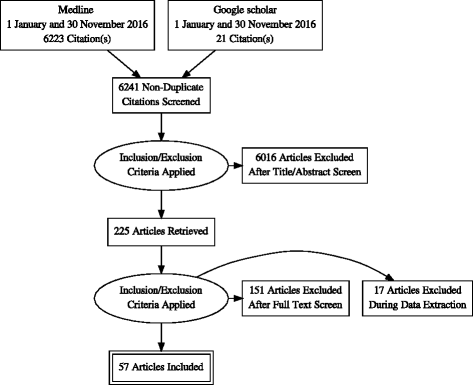The impact of programs for prevention of mother-to-child transmission of HIV on health care services and systems in sub-Saharan Africa - A review
- PMID: 29450099
- PMCID: PMC5809942
- DOI: 10.1186/s40985-017-0072-5
The impact of programs for prevention of mother-to-child transmission of HIV on health care services and systems in sub-Saharan Africa - A review
Abstract
Background: The global scale-up of Prevention of mother-to-child transmission (PMTCT) services is credited for a 52% worldwide decline in new HIV infections among children between 2001 and 2012. However, the epidemic continues to challenge maternal and paediatric HIV control efforts in Sub Saharan Africa (SSA), with repercussions on other health services beyond those directly addressing HIV and AIDS. This systematised narrative review describes the effects of PMTCT programs on other health care services and the implications for improving health systems in SSA as reported in the existing articles and scientific literature. The following objectives framed our review:To describe the effects of PMTCT on health care services and systems in SSA and assess whether the PMTCT has strengthened or weakened health systems in SSATo describe the integration of PMTCT and its extent within broader programs and health systems.
Methods: Articles published in English and French over the period 1st January 2007 (the year of publication of WHO/UNICEF guidelines on global scale-up of the PMTCT) to 31 November 2016 on PMTCT programs in SSA were sought through searches of electronic databases (Medline and Google Scholar). Articles describing the impact (positive and negative effects) of PMTCT on other health care services and those describing its integration in health systems in SSA were eligible for inclusion. We assessed 6223 potential papers, reviewed 225, and included 57.
Results: The majority of selected articles offered arguments for increased health services utilisation, notably of ante-natal care, and some evidence of beneficial synergies between PMTCT programs and other health services especially maternal health care, STI prevention and early childhood immunisation. Positive and negative impact of PMTCT on other health care services and health systems are suggested in thirty-two studies while twenty-five papers recommend more integration and synergies. However, the empirical evidence of impact of PMTCT integration on broader health systems is scarce. Underlying health system challenges such as weak physical and human resource infrastructure and poor working conditions, as well as social and economic barriers to accessing health services, affect both PMTCT and the health services with which PMTCT interacts.
Conclusions: PMTCT services increase to some extent the availability, accessibility and utilisation of antenatal care and services beyond HIV care. Vertical PMTCT programs work, when well-funded and well-managed, despite poorly functioning health systems. The beneficial synergies between PMTCT and other services are widely suggested, but there is a lack of large-scale evidence of this.
Keywords: Health systems integration; Maternal and child health; PMTCT; Sub Saharan Africa.
Conflict of interest statement
MJC is a MHA, MSc, MA, MPhil and PhD candidate in Global Health. CZ is a MD, MPH and PhD in Medical Anthropology. HT is a M.Sc and PhD in Epidemiology.Not applicable.Not applicable.The authors declare that they have no competing interests.Springer Nature remains neutral with regard to jurisdictional claims in published maps and institutional affiliations.
Figures
Similar articles
-
Integrating the prevention of mother-to-child transmission of HIV into primary healthcare services after AIDS denialism in South Africa: perspectives of experts and health care workers - a qualitative study.BMC Health Serv Res. 2020 Jun 26;20(1):582. doi: 10.1186/s12913-020-05381-5. BMC Health Serv Res. 2020. PMID: 32586318 Free PMC article.
-
Prevention of mother to child transmission of HIV (PMTCT) programme in KwaZulu-Natal, South Africa: an evaluation of PMTCT implementation and integration into routine maternal, child and women's health services.Trop Med Int Health. 2010 Sep;15(9):992-9. doi: 10.1111/j.1365-3156.2010.02576.x. Epub 2010 Jun 17. Trop Med Int Health. 2010. PMID: 20561313
-
Accelerating progress towards the elimination of mother-to-child transmission of HIV: a narrative review.J Int AIDS Soc. 2020 Aug;23(8):e25571. doi: 10.1002/jia2.25571. J Int AIDS Soc. 2020. PMID: 32820609 Free PMC article. Review.
-
Loss to Followup: A Major Challenge to Successful Implementation of Prevention of Mother-to-Child Transmission of HIV-1 Programs in Sub-Saharan Africa.ISRN AIDS. 2012 Jul 31;2012:589817. doi: 10.5402/2012/589817. ISRN AIDS. 2012. PMID: 24052879 Free PMC article. Review.
-
Operational issues and barriers to implementation of prevention of mother-to-child transmission of HIV (PMTCT) interventions in Sub-Saharan Africa.Curr HIV Res. 2013 Mar;11(2):144-59. doi: 10.2174/1570162x11311020007. Curr HIV Res. 2013. PMID: 23432490 Review.
Cited by
-
The Mentor Mothers Program in the Department of Defense in Nigeria: An Evaluation of Healthcare Workers, Mentor Mothers, and Patients' Experiences.Healthcare (Basel). 2021 Mar 14;9(3):328. doi: 10.3390/healthcare9030328. Healthcare (Basel). 2021. PMID: 33799489 Free PMC article.
-
Integrating the prevention of mother-to-child transmission of HIV into primary healthcare services after AIDS denialism in South Africa: perspectives of experts and health care workers - a qualitative study.BMC Health Serv Res. 2020 Jun 26;20(1):582. doi: 10.1186/s12913-020-05381-5. BMC Health Serv Res. 2020. PMID: 32586318 Free PMC article.
-
Investigation of prevention of mother to child HIV transmission program from 2011 to 2017 in Suzhou, China.Sci Rep. 2018 Dec 24;8(1):18071. doi: 10.1038/s41598-018-36623-6. Sci Rep. 2018. PMID: 30584264 Free PMC article.
-
From trauma to transmission: exploring the intersection of adversity, substance use, and HIV risk in women's life histories.Int J Equity Health. 2023 Sep 1;22(1):174. doi: 10.1186/s12939-023-01994-4. Int J Equity Health. 2023. PMID: 37658358 Free PMC article.
-
Involvement of Male Partners of Pregnant Women in the Prevention of Mother-to-Child Transmission (PMTCT) of HIV in Haiti: A Mixed-Methods Study.Am J Mens Health. 2021 Mar-Apr;15(2):15579883211006003. doi: 10.1177/15579883211006003. Am J Mens Health. 2021. PMID: 33874810 Free PMC article.
References
-
- UNAIDS . Global report: UNAIDS report on the global AIDS epidemic 2013. Geneva: UNAIDS; 2013. p. 198.
-
- UNAIDS . HIV/AIDS fact sheet. 2016.
-
- AVERT . Prevention of mother-to-child transmission (PMTCT) of HIV. 2016. - PubMed
Publication types
LinkOut - more resources
Full Text Sources
Other Literature Sources
Research Materials


